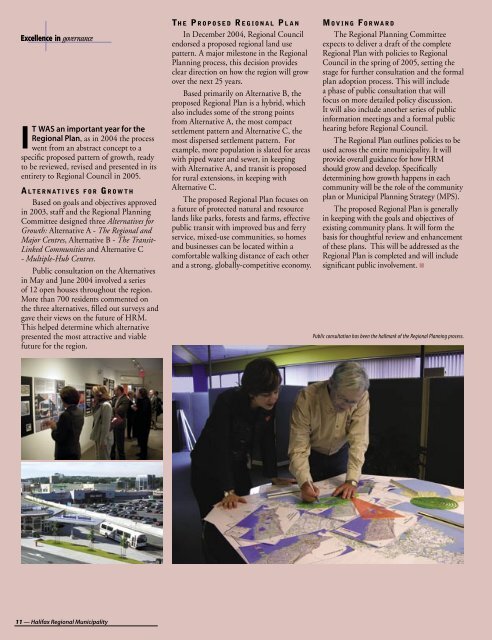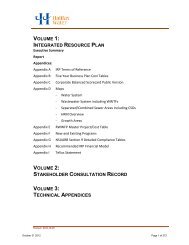Annual Report 2004 - Halifax Regional Municipality
Annual Report 2004 - Halifax Regional Municipality
Annual Report 2004 - Halifax Regional Municipality
Create successful ePaper yourself
Turn your PDF publications into a flip-book with our unique Google optimized e-Paper software.
I<br />
T WAS an important year for the<br />
<strong>Regional</strong> Plan, as in <strong>2004</strong> the process<br />
went from an abstract concept to a<br />
specific proposed pattern of growth, ready<br />
to be reviewed, revised and presented in its<br />
entirety to <strong>Regional</strong> Council in 2005.<br />
A LT E R N AT I V E S F O R GROW T H<br />
Based on goals and objectives approved<br />
in 2003, staff and the <strong>Regional</strong> Planning<br />
Committee designed three Alternatives for<br />
Growth: Alternative A - The <strong>Regional</strong> and<br />
Major Centres, Alternative B - The Transit-<br />
Linked Communities and Alternative C<br />
- Multiple-Hub Centres.<br />
Public consultation on the Alternatives<br />
in May and June <strong>2004</strong> involved a series<br />
of 12 open houses throughout the region.<br />
More than 700 residents commented on<br />
the three alternatives, filled out surveys and<br />
gave their views on the future of HRM.<br />
This helped determine which alternative<br />
presented the most attractive and viable<br />
future for the region.<br />
TH E P R O P O S E D R E G I O N A L P L A N<br />
In December <strong>2004</strong>, <strong>Regional</strong> Council<br />
endorsed a proposed regional land use<br />
pattern. A major milestone in the <strong>Regional</strong><br />
Planning process, this decision provides<br />
clear direction on how the region will grow<br />
over the next 25 years.<br />
Based primarily on Alternative B, the<br />
proposed <strong>Regional</strong> Plan is a hybrid, which<br />
also includes some of the strong points<br />
from Alternative A, the most compact<br />
settlement pattern and Alternative C, the<br />
most dispersed settlement pattern. For<br />
example, more population is slated for areas<br />
with piped water and sewer, in keeping<br />
with Alternative A, and transit is proposed<br />
for rural extensions, in keeping with<br />
Alternative C.<br />
The proposed <strong>Regional</strong> Plan focuses on<br />
a future of protected natural and resource<br />
lands like parks, forests and farms, effective<br />
public transit with improved bus and ferry<br />
service, mixed-use communities, so homes<br />
and businesses can be located within a<br />
comfortable walking distance of each other<br />
and a strong, globally-competitive economy.<br />
M O V I N G FO R WA R D<br />
The <strong>Regional</strong> Planning Committee<br />
expects to deliver a draft of the complete<br />
<strong>Regional</strong> Plan with policies to <strong>Regional</strong><br />
Council in the spring of 2005, setting the<br />
stage for further consultation and the formal<br />
plan adoption process. This will include<br />
a phase of public consultation that will<br />
focus on more detailed policy discussion.<br />
It will also include another series of public<br />
information meetings and a formal public<br />
hearing before <strong>Regional</strong> Council.<br />
The <strong>Regional</strong> Plan outlines policies to be<br />
used across the entire municipality. It will<br />
provide overall guidance for how HRM<br />
should grow and develop. Specifically<br />
determining how growth happens in each<br />
community will be the role of the community<br />
plan or Municipal Planning Strategy (MPS).<br />
The proposed <strong>Regional</strong> Plan is generally<br />
in keeping with the goals and objectives of<br />
existing community plans. It will form the<br />
basis for thoughtful review and enhancement<br />
of these plans. This will be addressed as the<br />
<strong>Regional</strong> Plan is completed and will include<br />
significant public involvement. ■<br />
Public consultation has been the hallmark of the <strong>Regional</strong> Planning process.<br />
Caption: Mill Cove (below), Transit (above ), Urban Design Awards<br />
(above lef t).<br />
11 — <strong>Halifax</strong> <strong>Regional</strong> <strong>Municipality</strong>

















